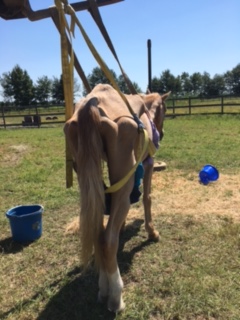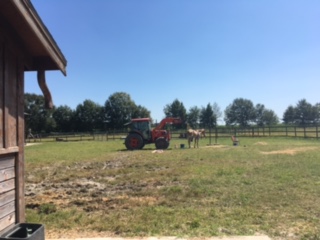Not long after I wrote this story about Trooper, he passed from this earth surrounded by those who gave him their all and a chance at life. I am posting this story to keep his spirit alive, so that others who read his story will speak out for abused animals. The people who are responsible for Trooper’s death are still out there. If you live in Southern Louisiana and know anything about who did this to Trooper, please call your local sheriff’s office. You can report what you know without giving your name.
May no animal suffer as Trooper did.

Trooper with his biggest fan, Rebecca Kopp
~
They came to name him Trooper, the skeletal horse found stumbling along a highway near St. Martinville, Louisiana, ten days ago. Horse experts who saw him knew his smooth coat came from life inside a stall, his legs suffering from mud rot from standing for the better part of a year in his own excrement. He waited without food. A motorist who saw him called law enforcement. They brought the wracked creature to the St. Martin Animal Shelter already overrun by dogs and cats in the aftermath of Hurricane Harvey. Shelter Director Michelle Brignac stayed in the field with the emaciated horse for seven hours, putting out an SOS to the area volunteer fire department after he went down on the ground. She posted pictures on Facebook.
That evening, Sept. 5, Rebecca Kopp, a riding instructor with experience rescuing horses, agreed to take him and do everything she could to rehabilitate him at the stable where she worked in nearby New Iberia. His fate was tenuous. She helped him out of her own goodness and was willing to pay for his needs out of her own pocket until she was urged to start a GoFundMe campaign for Trooper.
“Camp Rebecca Kopp is in full swing!” she posted on Sept. 6. After a veterinarian left her the stable, she camped out all night in the field with the horse to monitor his temperature, intravenous fluids, food intake, elimination, medicine, and most importantly, keep him up on his feet. If he went down, he wouldn’t have the strength to stand up again, lactic acid would build in his atrophied muscles, his joints would continue to swell. She, her colleagues at the stable, her husband, and friends made Trooper a makeshift sling hoisted by a tractor lift to keep him aloft. Blood work and fecal samples showed he was only mildly anemic and had no underlying medical conditions other than starvation.

Trooper put in the first makeshift sling.
“Someone starved this horse and it didn’t happen overnight,” Rebecca wrote the first day Trooper was in her care. The person who starved Trooper and dropped him off on Smede Highway near Cade, Louisiana, has yet to be identified. People now close to Trooper believe that the horse was trailered to the highway, turned loose, and left to die. “Whoever did this didn’t want to be bothered dig a hole big enough to bury a horse. And who wants a dead horse on their property,” one person said.
On Sept. 6, Trooper fell to the ground outside the stable and he remained there for several hours. The vet came, and six people helped get him back on his feet. He went back in the rigged sling in the field and they set up an open-air tent to shield him from the sun, the weather mercifully “cooler” in sweltering Southern Louisiana. Rebecca pitched a tent next to him in the field and checked on him through the night. A resident donkey watched over them, ensuring no coyotes came close.
A Sept. 8th’s morning FB live update showed Trooper grazing, walking on his own power, with Rebecca upbeat and narrating his tenuous progress.
She posted pictures of him in his blue blanket, sun rising behind him, saying, “These pictures are important to me. Thirty-six hours ago I didn’t know if Trooper was going to see another sunrise. He was TIRED. But by some miracle–and prayers, tears, vet attention, and a whole lot of determination–here he is. Another glorious sunrise shines down upon him. This horse (in his poor condition) shouldn’t be alive, yet here he is, fighting for every day. We could learn a thing or two from his determination.”

Saturday morning and evening FB live updates were positive. Sunday he was doing so well that Rebecca abandoned “camp” and slept at home with her family. Monday went well with Trooper doing his “bucket” checks for food in the barn hallways and Rebecca saying, “He’s such a sweet soul. I can’t wait until he’s healthy.”

Sign outside Trooper’s stall.
And here’s where I want to talk about human nature. Trooper’s case displays the whole range of human nature, from the monster responsible for this innocent creature’s suffering to the angel who sleeps on concrete to tend to him through the night and then does it all over again, watching for what he needs, what he is telling her, what she needs to do to keep him from slipping from this earth, minute by minute. Think about what this horse has experienced at the hands of humans, from long-term cruel starvation to fierce, loving, round-the-clock care. He stands there in the field and lets his newfound allies prod him, hoist him up with brute yet gentle force, walk him, straighten his arthritic atrophied ankles, knowing most likely for the first time, a loving human touch, even when it hurts. He falls. Each time he gets up–with help, as best he can, he stands. Someone gave up on him a long time ago. Yet, weak as he is, he has not given up.

Tuesday morning’s FB live showed Rebecca sitting on the ground with Trooper on the ground behind her. She calmly asked if anyone could come help her get Trooper up again. The St. Martin Animal Shelter staff went. So did I. By the time I arrived they’d just gotten Trooper back up on his feet in the field and were rigging up the sling. When I put my hands on his neck and head, he stopped grazing and stood still, as if he was soaking in the love flowing from me to him. He didn’t move until I did. It’s as if he felt the love and knew it was part of his healing.

Rebecca catching some sleep as Trooper looks on.
Rebecca borrowed a camper and stayed in the field with him overnight. Wednesday morning saw him standing in his sling in the field, doing well, Rebecca taking a nap under the canopy as Trooper looked on. In a Wednesday morning writing class I teach to adults at a VITA program, we used Trooper as a topic for writing a mini-essay about whether steps should be taken to punish animal abusers. One woman wrote, “We are all here to love. Every living being feels pain. The person who abused him should go to jail.”
Helping hands abound. After Trooper fell due to uneven ground outside the barn, Rebecca’s husband, Tom, came to build a cable for the sling to slide across the stall for Trooper, where the ground was more even and soft. Tom was sick that day, but there he was, creating something to support the weakened horse–and help his wife, Trooper’s caretaker.

“He lets us help him, never fights us. We couldn’t do this if he did,” she said.
Trooper gained in strength on Sept. 7, and Rebecca let him out of his makeshift sling to walk freely and graze. The truth is Trooper’s life still hung in the balance.
Rebecca knew that the first two weeks were critical to his chances of making it through alive. She was there for him, even though she had young children at home and a husband who worked far away at times.

Troopers Troops, supporters who followed his progress through Rebecca’s FB updates watched every morning and evening with trepidation. Last night Rebecca posted an ominous message. “Bad night. May have to make some tough decisions in the morning.” A co-worker took a picture of Rebecca sleeping on the cement floor outside Trooper’s stall. Rebecca had asked Trooper’s fans for prayers for his miraculous strength. He’d been found hanging limp in his sling with no strength to stand on his own. They had to cut him out of his sling and lower him onto the ground. He wasn’t responsive. Rebecca had stepped out to shower and change clothes. When she got the call about Trooper, she rushed back. The vet came and administered fluids and medicine to help with inflammation in nerves. They decided to sedate Trooper to allow him to rest and not struggle to stand. “Mr. Trooper, when he gets an idea in his head, he’s going to do it (try to stand up).” Several people helped him up again.
“He teeter-tottered on his feet, couldn’t get a foothold, knuckled over on both legs. A rough go. Most people stayed til 3 a.m.,” she said. He didn’t go down again. “Euthenasia is always on the table in a case like this. I didn’t have to make that decision this morning. He’s standing up, eating. It’s hour by hour. I set myself a time limit to be fair to him. If he’s not better by the end of the weekend we’ll have to make a tough call–to be kind to him. Hopefully he’ll keep trucking on, being Trooper, being the super horse he is,” she says.
They’ll reevaluate him regularly as to where he stands, with the hope he’ll get stronger. His age–mid to late 20s–is working against him. He doesn’t heal as fast as younger horses. Falling is hard on his ravaged body. “We’re approaching that critical two-week mark (as to whether he’ll heal and live). But if we don’t see strengthening in his leg, there’s not a whole lot more we can do. It’s the muscle weakness. It’s not fair to his mind, body, organs to keep going through this,” she says.
Yet, this morning, he was back “to yelling at me this morning for feed.” Rebecca believes Trooper will tell her when and if he is ready to give up the fight. She’s watching him carefully, alert to the signs and will do what is in his best interests.
“You know me, I’m a dreamer of the impossible things. I will keep trying til it’s not right anymore for quality of life. I’ll let him tell us how much further he’s willing to push. We’re okay for now and hoping he’ll continue to pull through.”

Shelter director Michelle Brignac on seeing Rebecca’s difficult update posted: “They are fighting right now to save the life of a horse that someone threw away like garbage. We love you, Trooper. We love you so much that we prayed and angels were sent to help you, to show you love.”
Rebecca gains much strength from Trooper’s and her supporters who visit, post messages of support, and from those who support the his GoFundMe campaign.
Her latest update today is hopeful: “He’s locked out his ankles, meaning he’s bearing weight on both ankles. Someone’s listening to our prayers. This is progress I didn’t expect to see today. These little things are what carry me through.”
Trooper has shown a whole community the full range of human nature. May his life teach us to be kind, to love all life, to seek justice, to never give up.

The day Trooper and I met.
–Sandra Sarr
September 15, 2017





















